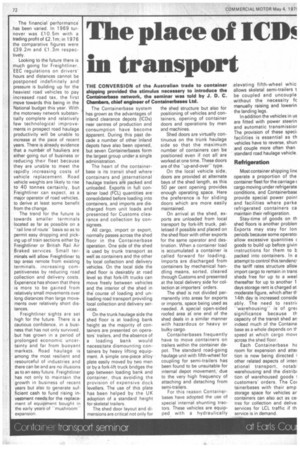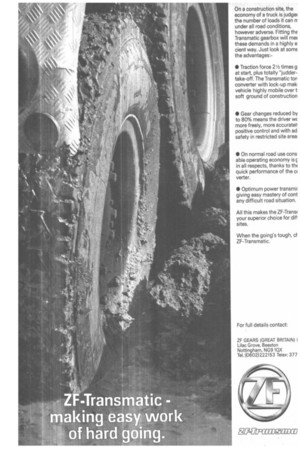The place of ION in transport
Page 74

Page 75

If you've noticed an error in this article please click here to report it so we can fix it.
THE CONVERSION of the Australian trade to container shipping provided the stimulus necessary to introduce the Containerbase network, the seminar was told by J. D. C. Chambers, chief engineer of Containerbases Ltd.
The Containerbase system has grown as the advantages of inland clearance depots (ICDs) near centres of production and consumption have become apparent. During this past decade a number of other inland depots have also been opened, but seven Containerbases form the largest group under a single administration.
The heart of the containerbase is its transit shed where containers and international haulage trailers are packed and unloaded. Exports in full container load (FCL) quantities are consolidated before loading into containers, and imports are discharged from unit loads and presented for Customs clearance and collection by consignees.
All cargo, import or export, normally passes across the shed floor in the Containerbase operation. One side of the shed is used by trunk transport as well as containers and the other by local collection and delivery vehicles. On the local side the shed floor is desirably at road level so that fork-lift trucks can move freely between vehicles and the interior of the shed in the course of loading and unloading road transport providing local collection and delivery services.
On the trunk haulage side the shed floor is at loading bank height as the majority of containers are presented on operators' trailers, and the absence of a loading bank would necessitate dismounting containers by heavy lifting equipment. A simple one-piece alloy plate easily moved by two men or by a fork-lift truck bridges the gap between loading bank and container, thus avoiding the provision of expensive dock levellers. The use of this plate has been helped by the UK adoption of a standard height for skeletal trailers.
The shed door layout and dimensions are critical not only for the shed structure but also for positioning of vehicles and containers, opening of container doors and operations by men and machines.
Shed doors are virtually continuous on the trunk haulage side so that the maximum number of containers can be positioned even if not all are worked at one time. These doors are of the -up-and-over" type.
On the local vehicle side, doors are provided at alternate bays of the shed length, as this 50 per cent opening provides enough operating space. Here the preference is for sliding doors which are more easily maintained.
On arrival at the shed, exports are unloaded from local transport by fork-lift truck, palletised if possible and placed on the shed floor with other exports for the same operator and destination. When a container load is accumulated a container is called forward for loading. Imports are discharged from containers by mechanical handling means, sorted, cleared through Customs and presented at the local delivery side for collection at importers' orders.
The shed is not divided permanently into areas for exports or imports, space being used as needed. A special open-sided roofed area at one end of the shed deals in a similar manner with hazardous or heavy or bulky cargo.
Containerbases frequently have to move containers on trailers within the container depot. The standard road-going haulage unit with fifth-wheel for coupling for semi-trailers has been found to be unsuitable for internal depot movement, due to the very high frequency of attaching and detaching from semi-trailers.
For this reason Containerbases have adopted the use of special internal shunting tractors. These vehicles are equipped with a hydraulically elevating fifth-wheel whic allows skeletal semi-trailers t be coupled and uncouple without the necessity fc manually raising and lowerin the landing legs.
In addition the vehicles in us are fitted with power steerin and automatic transmissior The provision of these speck facilities is essential as th vehicles have to reverse, shun and couple more often than standard road haulage vehicle.
Refrigeration
Most container shipping line operate a proportion of the container fleet for the carriage cargo moving under refrigerate conditions, and Containerbase provide special power poinI and facilities where parke refrigerated containers ca maintain their refrigeration.
Stay-time of goods on th shed floors is another problerr Exports may stay for Ion periods because some operatoi allow excessive quantities goods to build up before givin instructions for them to b packed into containers. In a attempt to control this tendenc, the tariff rates structure alloy\ import cargo to remain in trans sheds free for up to a wedl thereafter for up to another 1 days storage rent is charged at moderate figure, which after th 14th day is increased conside ably. The need to restrir 'warehousing'' is of grei significance because th capacity of the transit shed an indeed much of the Containe base as a whole depends on if speed at which cargo MOVE across the shed floor.
Each Containerbase he room for expansion and atter tion is now being directed 1 other related aspects of interi ational transport, notabl warehousing and the distribi tion of warehoused goods 1 customers' orders. The Cor tainerbases with their amp storage space for vehicles ar containers can also act as cei tres for collection and delivei services for LCL traffic if th service is in demand.
On a construction site, the economy of a truck is judge( the number of loads it can nr under all road conditions, however adverse. Fitting thE Transmatic gearbox will me( these demands in a highly e cient way. Just look at SOME the advantages: • Traction force 21/2 times g at start, plus totally "juddertake-off. The Transmatic tor converter with lock-up mak vehicle highly mobile over t soft ground of construction • Gear changes reduced by to 80% means the driver wc more freely, more accuratel, positive control and with ad safety in restricted site area • On normal road use cons able operating economy is c in all respects, thanks to th( quick performance of the c( verter.
• Optimum power transmi! giving easy mastery of cont any difficult road situation.
All this makes the ZF-Transi your superior choice for dif sites.
When the going's tough, c[ ZF-Transmatic.
























































































































